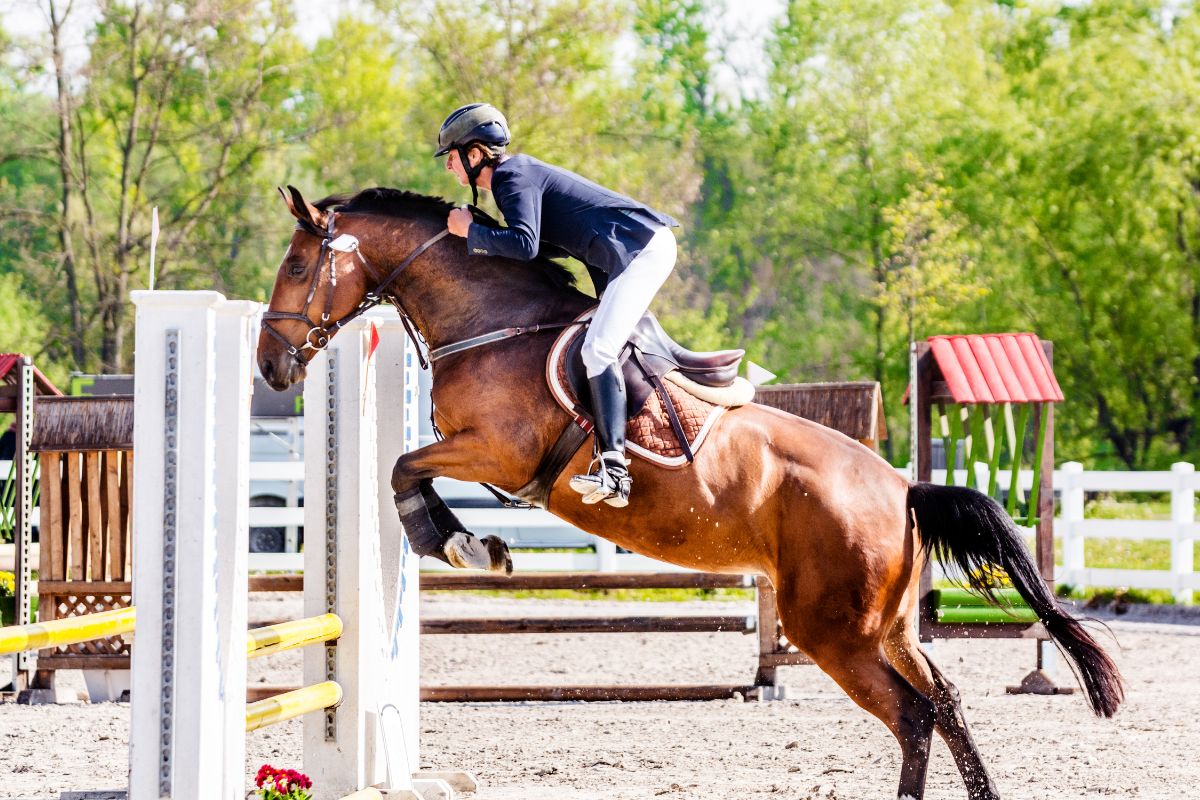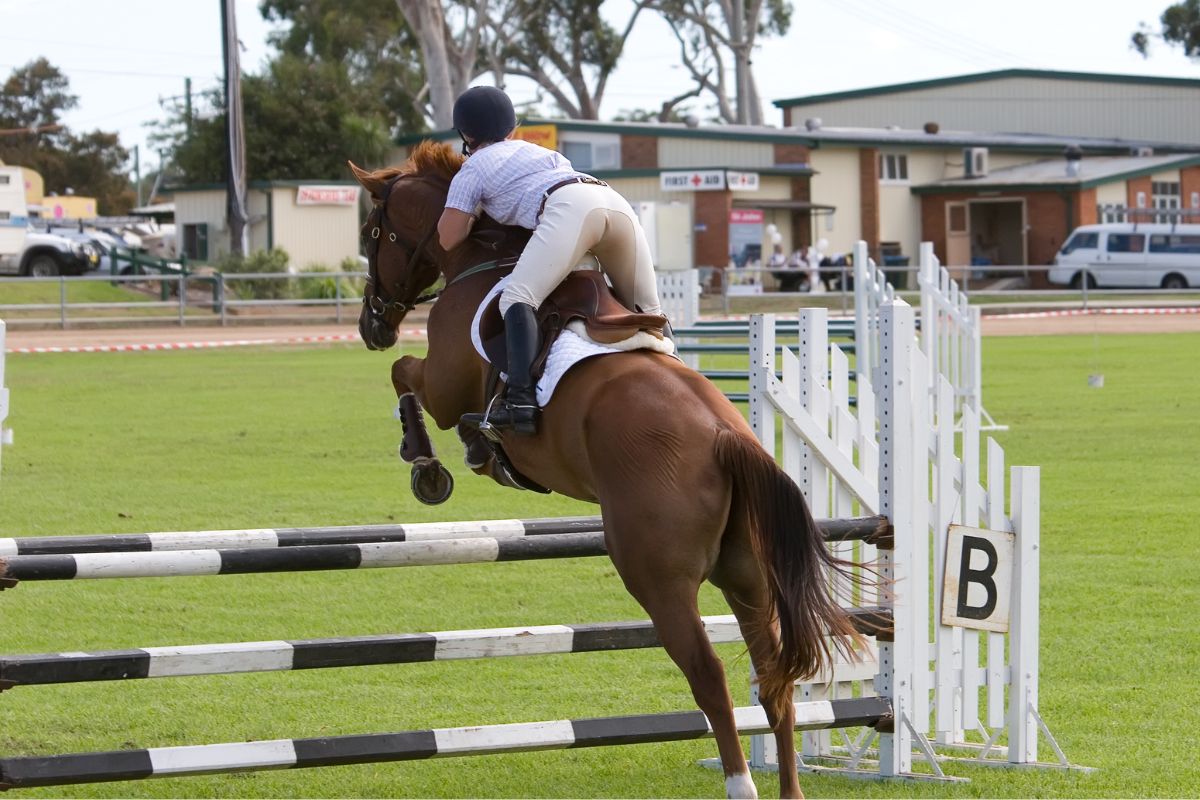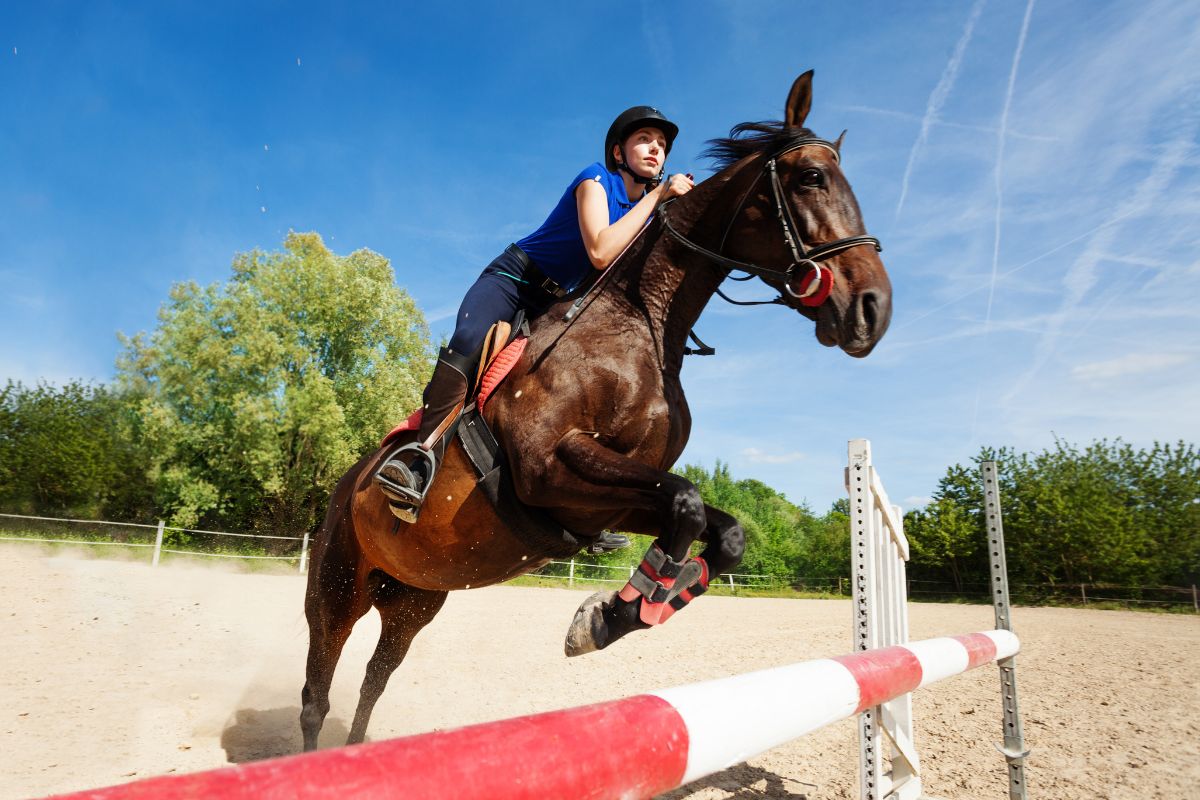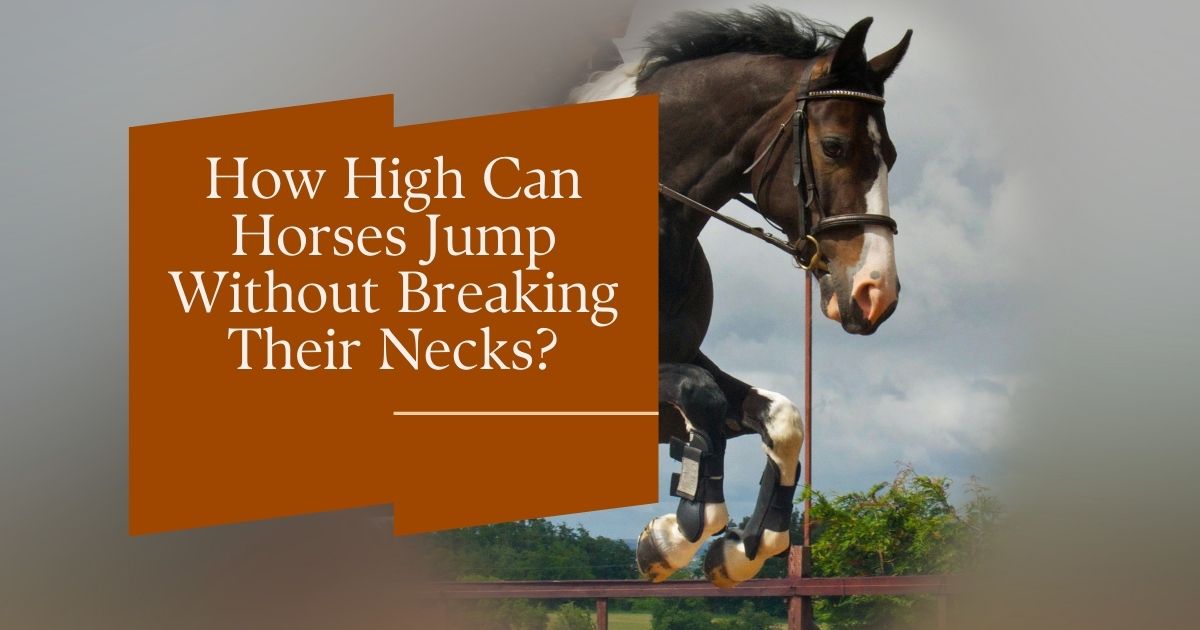Jumping Horses
How high can horses jump? Seeing a galloping horse leaping over a fence never fails to impress because horses are gorgeous animals. Horse leaping is still a superb skill that calls for extensive training for both the rider and the horse.
Some horses have a natural ability to jump high, especially when they are afraid or searching for food. Others, though, just a little more inspiration to overcome a minor challenge.

How High Can Horses Jump?
The majority of horses have the natural ability to make a jump of about three feet without having to be in training. Still, for them to do so, they will need some motivation. This could be another horse in another field they are trying to reach, food, or even fear; any of these things can motivate them to make a high jump.
In addition to these factors, the ability of a horse to jump is typically the result of careful training and consistent practice. Two attributes are necessary for a horse to be an excellent jumping horse:
- The physical capacity to propel the horse’s body into the air, and
- The mental combination of bravery and spirit.
Additionally, it needs to have the urge to be careful and to avoid touching the peak of a jump with either its body or its hooves in any way. This final skill can be what separates a good jumper from a bad one. It’s great if you can get the height just perfect, but if you always trail a hoof, you’re going to knock down a rail and end up not winning any awards.
How High are the Fences in Olympic Show Jumping?
Because the vast majority of horses do not have the training to jump properly nor leap precisely, the fences at the beginner level of competition are always lower than three feet (0.91 meters).
However, when it comes to horses you can use in competition, not only are they specific breeds for jumping, but they have also been through significant training over many years before ever getting a chance to compete internationally.
The show jumping fences at the Olympics must be above 6 feet (1.8 meters). Keeping this in mind, Olympic jumps, along with all other top-level obstacles, test the horse and rider’s ability to leap fences at a high rate of speed. This happens to push both the horse and the rider to their limits.
The jumps will test both the height to which they can jump and the distance that they are capable of jumping; however, because of the speed component, the fences can only have a maximum height of 5 feet (1.6 meters). Their breadth is likewise regulated, although the type of jump determines the full width.
For instance, a regular jump will be no wider than 6.6 feet (2 meters), while triple fences will be no broader than 7.2 feet (2.2 meters). Water jumps should not exceed 14 feet (4.5 meters).
The Current World Record Horse Jump
Huaso, an ex-Faithful in Chile, set the highest horse jump ever record for a horse’s vertical leap in 1949 at 8 feet (2.4 meters), 1.25 inches (3.2 centimeters). A typical horse can jump only roughly three feet (0.9 meters).
However, the horses employed in competitive jumping can clear heights of more than seven feet. The table below summarises different horse jump world records:
| Equine Jumping Records | Horses’ Name | Rider | Height | Year |
| World Record | Huaso, ex-Faithful | Capt. Alberto Larraguibel Morales | 8 feet (2.47 meters) | 1949 |
| Puissance World Record | Optiebeurs Golo | Frank Sloothaak | 7 feet (2.38 meters) | 1991 |
| North American Record | Sweet N’ Low | Anthony D’Ambrosio | 7 feet (2.38 meters) | 1983 |
| British Record | Lastic | Nick Skelton | 7 feet (2.38 meters) | 1978 |
Different Horse Jumping Types
Horses are prey animals fleeing predators by running and jumping. They can grab an apple from a tree or even jump over a fence out of instinct to escape a frightening situation. A professional rider aims to teach a horse to overcome various challenges.
The discipline the rider trains the animal for determines the height of the barrier. There are different kinds of horse jumping:
- The high-jumping over barriers of varying heights.
- The so-called great wall and a warm-up fence are used in Puissance jumping.
- Showjumping involves scaling a wall, typically 3 to 4 feet (0.91 to 1.22 meters).
- Leaping during equine competition.
- Steeplechasing, which involves jumping over low barriers in high-speed racing.
The table below summarises different obstacle heights that a rider can use to teach a horse to overcome several obstacles.
| Level | Obstacle Height |
| 0 | 30 to 33 inches (76.2 to 83.8 centimeters) |
| 1 | 33 to 36 inches (83.8 to 91.4 centimeters) |
| 2 | 36 to 39 inches (91.4 to 99.1 centimeters) |
| 3 | 39 to 42 inches (99.1 to 106.7 centimeters) |
| 4 | 42 to 45 inches (106.7 to 114.3 centimeters) |
| 5 | 45 to 48 inches (114.3 to 121.9 centimeters)) |
| 6 | 48 to 51inches (121.9 to 129.5 centimeters) |
| 7 | 51 to 54 inches (129.5 to 137.2 centimeters) |
| 8 | 54 to 57 inches (137.2 to 144.8 centimeters) |
| 9 | 57 to 60 inches (1.45 to 1.5 m) |
Before attempting a leap on a horse, the rider must first get the animal warmed up and then bring it up to a trot, canter, or gallop. A horse cannot jump from a standing posture. As soon as the horse gets close enough to an obstruction, it will alter its pace and bring its hind legs closer to its center of gravity.
At the same time, the horse’s front legs will lengthen, and its withers will sink downward. There are normally five stages to a horse’s jump, although each horse has its unique style:
- Approach
- Takeoff
- Bascule (or arc in motion)
- Landing
- Recovery

Factors Affecting Horse Jumping Height
In general, any horse can jump obstacles between 2 and 3 feet in height (0.6 to 0.9 meters). However, the ability of a specific animal to jump high will depend on several circumstances. Let’s see.
Horse Measures
The horse will require more energy from the horse if it is heavier for it to jump over a higher fence effectively. When it comes to height, however, the opposite is true: it is simpler for taller horses to leap over higher obstacles.
Most trainers agree that a horse should be around 16 hands (1.62 meters) before beginning jumping training. However, any pony or low horse of any breed may jump over a minor obstacle less than 3 feet (0.9 meters) in height, including different types of horses.
Horse Age
You won’t have trouble teaching foals to appreciate jumping because they are active and enjoy playing, both of which are prerequisites for the activity. Untrained animals, on the other hand, lack the self-control and patience necessary to solve challenges systematically.
Most riders prefer to use horses between 1 and 3 years old for high jumping and show jumping. After a horse reaches the age of three or four, the maximum height to which it can jump begins to decrease.
Horse Breed
Because of differences in leg length, body shape, temperament, and stamina, the breed of a horse considerably impacts the height to which it can jump. Although it is possible to teach any horse to jump given enough time and effort, elite riders typically choose horses of one of the following breeds:
- Holsteiner
- Hanoverian
- Sporting horse of Irish descent
- Thoroughbred
- Quarter horse bred in the United States
- Warmblood de Germanie
- Arabian
- Appaloosa
The rider’s weight and level of experience, the nature of the obstacle, the horse’s training, and the type of competition in which the horse participates are just some of the other factors that can influence the height of the jump.
Average Horse Jump Heights
What is the highest a horse has ever jumped? If you have a farm horse, you should know that it can easily leap over a 3 feet (0.9 meters) tall wall and leave the estate for wild horses, the same holds. When necessary, they can leap over obstructions that are 2 to 3 feet (0.6 to 0.9 meters) high.
However, they may jump much higher when their adrenaline levels are high. For instance, a threatened animal will scale 5 feet (1.5 meters) high barrier. Unexpectedly, it is not the highest height your horse can grow to. As I already said, the maximum jump height depends on several variables, including animal training.
You can gradually raise the bar after your horse is comfortable leaping a fence 3 feet (0.9 meters) high. When increasing the obstacle’s height, you should estimate a few inches. With practice, you may easily teach your horse to leap over 5 or even 6 feet (1.5 or 1.8 meters) high walls.
Equine Jump Sequences
Although horses can learn to appreciate jumping high with positive reinforcement during training, the jump is always stressful for the horse’s body. Tendons stretch and muscles strain, which increases the risk of injury.
An experienced rider can lead a horse safely over a high obstacle. To prevent injuries, quality footwear and grooming are crucial.
Never neglect to warm up your horse before a jump. Additionally, you must consider how hard the ground is where you are training your animal. You can prevent them from inflammation, severe bone bruising, sore feet, and suspensory ligament rips.
It’s also important to consider the duration and intensity of the workout. You can create a daily schedule to assist your horse by consulting an expert in horse training. Your horse will suffer lifelong injuries or possibly pass away due to a broken leg or spine if you overwork it and push it past its breaking point.
Never forget that horses rarely jump in the wild just for fun. A horse must jump to escape predators or reach for food. In nature, survival is the only goal. Consequently, the regular training of a show-jumping horse is always unpleasant for the animal. It will require a lot of rest and vitamins because it will consume more calories and routine veterinary exams.
Even with all of the aforementioned, cartilage deteriorates over time, tendons deteriorate, and muscle and bone deteriorate. In other words, you can never sustain a horse’s career in jumping.
Our Tips for Horse Jumping
Even if you have a well-trained horse, you should be careful not to ride over exceptionally high fences if you are a less experienced rider. Before jumping, bear in mind the following:
- To avoid throwing off your horse’s balance, never gaze down but instead straight over the obstacle.
- Before high-jumping, slightly shorten your stirrups.
- Remain calm because the animal can sense your fear.
- If you lack self-assurance, your horse may readily refuse to jump and stop, causing you to fall.
- If you continually jump the same fence, attempt to aim for the center of the obstruction. After the jump, alternately spin to the left and the right to keep the horse from growing bored.
- If the horse declines to jump the fence, do not penalize it. Directing it to trot in a small circle around the obstruction is preferable before trying again.

A Final Word
Watching horses jumping high is quite an interesting experience. A typical untrained horse can jump up to 2 to 3 feet (0.6 to 0.9 meters). Nevertheless, you can teach your animal to jump higher depending on its age, breed, and the sort of obstacle.
Jump height also greatly depends on the rider’s and horse’s abilities. You should exercise caution when practicing and competing because a horse can sustain lifelong injuries when jumping.
